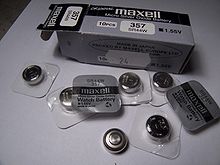
Back بطارية أكسيد الفضة Arabic Stříbro-oxidový článek Czech Silberoxid-Zink-Batterie German Pila de óxido de plata Spanish Hõbeoksiidelement Estonian باتری نقره-اکسید Persian Pile oxyde d'argent French सिल्वर आक्साइड सेल Hindi Srebrov oksid baterija Croatian 酸化銀電池 Japanese
This article needs additional citations for verification. (May 2008) |
 Silver oxide cells | |
| Specific energy | 130 Wh/kg[1] |
|---|---|
| Energy density | 500 Wh/L[1] |
| Specific power | High |
| Charge/discharge efficiency | N/A |
| Energy/consumer-price | Low |
| Time durability | High |
| Cycle durability | N/A |
| Nominal cell voltage | 1.55V |

A silver oxide battery (IEC code: S) is a primary cell using silver oxide as the cathode material and zinc for the anode. These cells maintain a nearly constant nominal voltage during discharge until fully depleted.[2] They are available in small sizes as button cells, where the amount of silver used is minimal and not a prohibitively expensive contributor to the overall product cost.
Silver oxide primary batteries account for 30% of all primary battery sales in Japan (64 out of 212 million in February 2020).[3]
Large silver oxide batteries were used on early ICBM's and satellites because of their high energy-to-weight ratio. For example the Corona reconnaissance satellites used them, as did the Agena-D rocket upper stage.[4] Later, they were also used in the Apollo Lunar Module and lunar rover.[5][6]
- ^ a b "ProCell Silver Oxide battery chemistry". Duracell. Archived from the original on 2009-12-20. Retrieved 2009-04-21.
- ^ "Silver Oxide Batteries". muRata. Retrieved 25 November 2020.
- ^ "Monthly Battery Sales Statistics". Baj.or.jp. MoETI. May 2020. Archived from the original on 2010-12-06. Retrieved 2020-08-07.
- ^ "Feasibility Study, Final Report, Geodetic Orbital Photographic Satellite System, Volume 2" (PDF). NRO. June 1966. Archived from the original (PDF) on 2012-03-16. Retrieved 2011-01-28.
- ^ Clemens, Kevin (2019-07-05). "The Batteries That Powered the Lunar Module". designnews.com. Retrieved 2021-02-02.
- ^ Lyons, Pete; "10 Best Ahead-of-Their-Time Machines", Car and Driver, Jan. 1988, p.78
© MMXXIII Rich X Search. We shall prevail. All rights reserved. Rich X Search